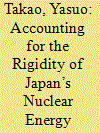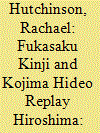|
|
|
Sort Order |
|
|
|
Items / Page
|
|
|
|
|
|
|
| Srl | Item |
| 1 |
ID:
167213


|
|
|
|
|
| Summary/Abstract |
This article examines the seven decades since the end of World War II and the evolution of Japan’s nuclear energy policy from the perspective of both domestic/international structures and coalition building processes. The objective is to identify the causal mechanism that has produced the rigidity of today’s Japanese nuclear energy policy. This study takes an analytically eclectic approach. Viewing the single puzzle of policy rigidity through two different lenses, political opportunity structures and advocacy coalition framework accounts for different facets of Japan’s nuclear energy policy. This approach can also connect otherwise contending frameworks together to reveal factors in the policy rigidity of nuclear energy.
|
|
|
|
|
|
|
|
|
|
|
|
|
|
|
|
| 2 |
ID:
167209


|
|
|
|
|
| Summary/Abstract |
Since the introduction of ballet to Japan in the early 1900s, male dancers have figured prominently, with a profile equal to that of female dancers. Despite this, the association between ballet and girls’ cultures has been dominant in Japan, as in other cultures. As a consequence, ballet is often considered to be a highly ‘feminine’ activity, with associations as a ‘queer’ activity for males in contemporary culture. What does the increase in visibility of ballet in Japanese boys’ culture tell us? This paper examines Japanese popular media that target boys and men as its core audience, especially the magazine Dancin’, possibly the first ballet magazine in the world exclusively for boys and young men. I examine how the magazine operates in contrast to the female version to attempt to create a virtual, imagined community that might offer a sense of belonging and encouragement to otherwise isolated ballet boys.
|
|
|
|
|
|
|
|
|
|
|
|
|
|
|
|
| 3 |
ID:
167210


|
|
|
|
|
| Summary/Abstract |
This essay examines how photography and news footage of the Hiroshima bomb have been used as a backdrop for the action genre in Japanese film and videogames. The case studies are Fukasaku Kinji’s film Battles without Honor or Humanity (1973), and Kojima Hideo’s videogame Metal Gear Solid (1998). Fukasaku’s opening sequence employs photographic stills of the mushroom cloud, burnt-out ruins, and the black market to set the violence of yakuza gangs against the political-military violence of the United States. A generation later, Kojima's game used photographic stills of the atomic bombing in a strikingly similar way, including footage of nuclear waste facilities and weapons manufacturing. Both texts position Japan as a victim, with Hiroshima symbolizing America’s abuse of technology and power. Although both texts belong to the action genre, there is a major difference in the subjectivity of the main characters, stemming from the different narrative trajectories of each text and the media specificity of cinema and games. Agency in Kojima's text allows the player to negotiate and reshape the historical memory of Hiroshima in their own experience, performing the anti-nuclear critique through in-game actions. Combining meaningful play with digital history, videogames are highly effective vehicles for political and social critique.
|
|
|
|
|
|
|
|
|
|
|
|
|
|
|
|
| 4 |
ID:
167211


|
|
|
|
|
| Summary/Abstract |
This article re-examines the often misrepresented role of Okinawan agency by focusing on the divergence between mainstream framings of Okinawa, actual policies directed towards the Ryūkyū Islands and the sociopolitical reality on these outlying islands. In so doing, it interrogates the various narratives of Okinawa and the key terms that have articulated them in the post-reversion era. It thereby adds explanatory power to extant structuralist and critical literatures, which have tended to suffer from monolithic descriptions of structural power and polemic approaches to American and Japanese governance of the islands. Specifically, by analyzing a series of illustrative issue areas such as sexual and economic exploitation, environmental protection and military security, the article uses an adapted form of critical discourse analysis (CDA) to trace how framings and policy have shifted since reversion to Japanese rule. This concentrates primarily on prime-ministerial statements from the National Diet and other, mostly Japanese-language, materials relating to Okinawa’s governance. These are contrasted with short case studies highlighting the disconnection between rhetoric and reality. Ultimately, the evidence points to a decoupling of mainstream narratives from the on-the-ground reality. The article thereby provides a nuanced understanding and expression of Okinawa’s complex interests and agency.
|
|
|
|
|
|
|
|
|
|
|
|
|
|
|
|
| 5 |
ID:
167212


|
|
|
|
|
| Summary/Abstract |
This article examines how Japanese perceptions of blackness and modern knowledge about bankoku (myriad lands) were formed in early modern Japan. From about the mid-seventeenth century until the mid-nineteenth century, Japanese intellectuals absorbed the Western sciences, technology, and medicine through contact with the Dutch in Nagasaki. This field of study is called rangaku (Dutch studies). In this context, the Japanese intellectuals expanded their knowledge about the world – specifically, geographical spaces and numerous races. During this process, they shaped their ethnic and racial stereotypes, including racist ones about black Africans. The idea of black inferiority became deeply embedded into Japanese geographical and anthropological knowledge. I use Michel Foucault’s idea of ‘genealogy’ as an analytical framework for a diagnosis of the current condition. My genealogical investigation of the concept of kokujin (blacks) reveals the historical processes in which Japan’s indigenous, pre-contact sangoku (three-land) cosmology became invalidated and marginalized from modernist discourses on bankoku. This approach enables a critique of modernity itself, which has been associated for centuries with global distributions of various forms of Western knowledge and power – those upon which our present-day practices and discourses still depend.
|
|
|
|
|
|
|
|
|
|
|
|
|
|
|
|
| 6 |
ID:
167214


|
|
|
|
|
| Summary/Abstract |
The term ‘sashiko’ refers to a quilting stitch used to sew together layers of material. The stitch itself is a simple running stitch, with the beauty created by complex interlocking stitching patterns. In Japan there is a long-standing tradition of layering and re-stitching material to create a thicker, warmer more durable garment. This was particularly true in the poorer regions of Tohoku during the Edo and early Meiji period where the lower classes used this stitching to create and decorate garments made out of homespun hemp and other plant fibres. After first contextualising the sashiko tradition, both in terms of its Edo origins and decreasing popularity in late Meiji, this paper focuses on the contemporary rebirth of sashiko as a form of decorative embroidery, and increasingly as a pure art form. In discussing the rekindled interest in this form of stitching, in both the contemporary quilting world and in the context of the global revival of traditional handicrafts, the paper concludes with reference to the work of contemporary sashiko artists and also to the use of sashiko garments in the final film made by the great director, Akira Kurosawa, Yume.
|
|
|
|
|
|
|
|
|
|
|
|
|
|
|
|
|
|
|
|
|